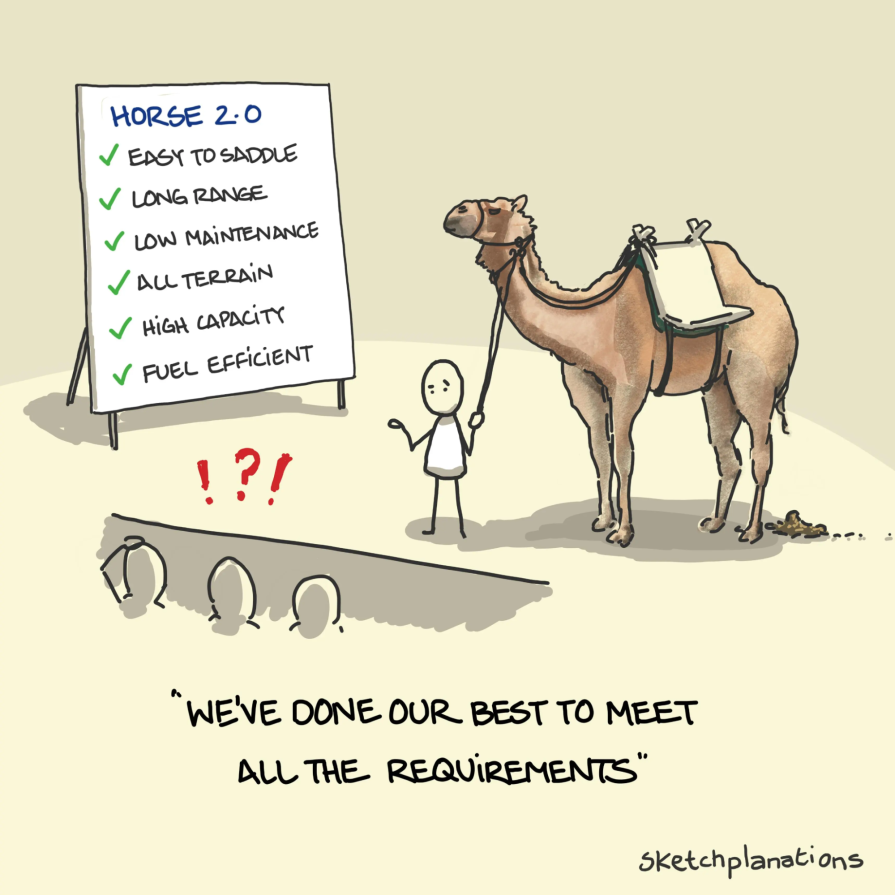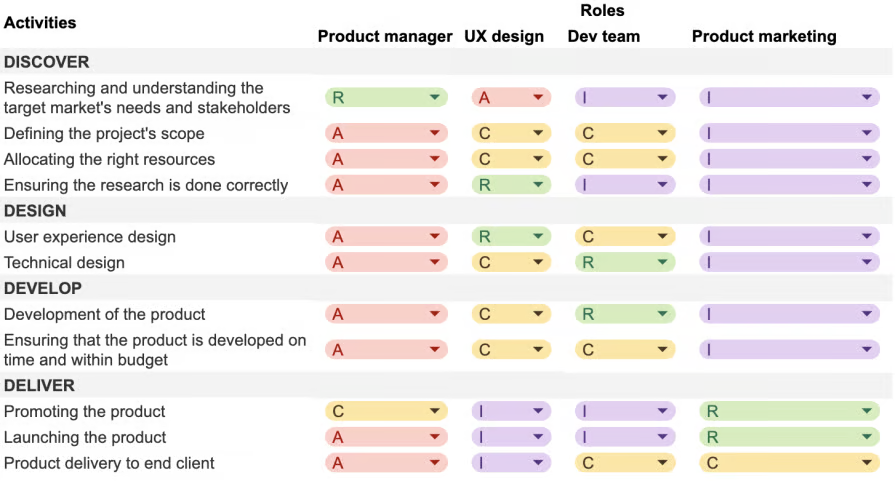I designed by committee — and here’s what went wrong
There’s a saying in the design world — “A camel is a horse designed by a committee.” A horse is elegant. Every part of their body has a purpose — built for speed, agility, and balance. A camel feels more like a compromise of decisions. While it’s suited for a different environment, it has awkward proportions, large humps, and is strange to the eye if you’re used to the sleekness of a horse. It’s functional, but not necessarily beautiful.
That’s what happens when too many voices, opinions, and priorities shape a UX design. You end up with something technically correct, but directionless. Functional, but uninspiring. It doesn’t move users forward — it leaves them confused or indifferent.
Let’s unpack why that happens, what it cost me as a designer, and how to protect your work before it turns into the UX equivalent of a camel:
Good ideas don’t survive a group edit
The best UX designs start with a strong, focused idea. Being intentional with your design is what separates unique, innovative ideas from generic, recycled ones. Whether it’s a website homepage, a mobile app, or a product interface, every element on the screen, from the layout to the copy to the colors, should support a clear, central goal of serving your users’ needs effectively and thoughtfully.
But in a committee-driven process, that vision rarely makes it out alive. Stakeholders start adding “must-have” features. Product wants more visibility for functionality. Marketing wants a highlight reel. Legal wants five disclaimers. Someone brings up a competitor doing X, so we should probably do X too.
This process results in scope creep, which is when a project gradually expands beyond its original, agreed-upon objectives. The design gets bloated. You’re not solving the original problem anymore — you’re solving everyone’s side quests. And the user? They’re now stuck with a cluttered, confusing experience.
Creativity dies when everyone needs to say yes
Designers thrive during the exploration phase. It’s the stage where designers sketch freely, imagine bold solutions, and chase a vision that may feel a little futuristic or unconventional. This kind of creative exploration requires freedom to take risks, break patterns, and reimagine what’s possible.
But when the process turns into a stakeholder approval gauntlet, creativity takes a backseat. Each stakeholder brings their own set of requirements, perspectives, and concerns. Every design decision is questioned, debated, and scrutinized. Designers quickly learn that to move forward, they must justify every pixel. As a result, they begin to pull back on their more ambitious ideas, knowing that anything too bold is less likely to get the green light.
Over time, this environment trains designers to prioritize approval over impact. Instead of designing the best solution for the user, they start thinking about what would get approved the quickest. There’s no longer a benefit to risky, innovative designs. Just move it forward. But “forward” isn’t the same as “better.”
And that’s how we end up with designs that technically check all the boxes — but feel completely forgettable.
Compromise isn’t collaboration
In theory, cross-functional teams should make products better. Product managers bring user insights. Engineers bring feasibility. Marketing brings brand. Sales wants to close deals. Legal keeps things compliant.
All valid. All important.
But when everyone’s goals are treated as equally important, and no one is willing to make trade-offs, the design becomes a mix of compromises. Instead of choosing one direction and building toward it, teams try to satisfy every stakeholder. This often results in a design that’s cluttered, inconsistent, and hard to use. With numerous agendas at play, design meetings can often be characterized by a constant back-and-forth without a clear direction.
I’ve seen it firsthand.
Case study: When onboarding tried to please everyone
I once worked on a new onboarding experience for our product with the goal of helping new users quickly get to value without overwhelming them. The original concept that I drafted was a short, guided flow with a couple of setup steps, followed by in-product tooltips. It was lightweight, fast, and got out of the user’s way.
Then came the feedback.
- PM wanted to emphasize three key features during onboarding to highlight the product’s value immediately
- Customer success asked for a detailed checklist with setup tasks, educational content, and completion of milestones to increase engagement and ensure users are set up for long-term success
- Engineering requested that the flow stay technically simple, which meant no dynamic branching, personalization, or complex logic that would require extra development time
Each of these asks made sense on its own. But instead of prioritizing them, the team decided to include everything.
The next iteration had:
- A multi-slide tour
- A mandatory checklist
- A one-size-fits-all flow
No room for personalization. No flexibility based on user needs. It looked like onboarding — but it didn’t feel like onboarding. It felt like a product demo in disguise.
Users noticed. Some said the flow felt made for someone else. Others felt overwhelmed. And worst of all, we failed to deliver on the original goal: helping users reach value quickly. The team was frustrated, too. We’d spent weeks designing something no one really believed in.
That’s the cost of design by committee.
Without ownership, design slows down
When no one owns the final decision, feedback loops never end. Everyone keeps tweaking, suggesting, questioning — even if they don’t fully understand the problem.
To get your house in order, sit down with your team to clarify each stakeholder’s roles and responsibilities throughout the product development process. In most cases where projects are suffering from a committee-driven process, team members don’t have a clear shared understanding of each other’s roles and responsibilities.
One tool that has helped is the RACI matrix. It stands for:
- Responsible – Who does the work?
- Accountable – Who makes the final decision?
- Consulted – Who gives input?
- Informed – Who needs to be kept in the loop?
It looks like this:
Here’s how we used it in later projects:
- Design was responsible during prototyping
- Product was accountable for prioritization
- Engineering was consulted for feasibility
- Customer success was informed about what’s coming
This gave us clarity. It didn’t shut people out — it just made sure everyone knew their role, and who had the final say.
Other tips to avoid design by committee
If you’re struggling with the challenges that come with design by committee, here are some additional tips to help improve your team’s collaboration and protect your design process.
Timebox feedback and review
Design iterations can go on forever, as there can always be something to change or improve for the future. But when feedback is allowed at any stage, it invites scope creep and can sidetrack your design from its main objective at the moment. Rather, invite feedback during a defined review window. For example, one week after the prototype is shared, or by the end of the sprint. After that, it’s time to move forward. No retroactive requests.
Prioritize ruthlessly
If feedback is received after the window has closed, save it and prioritize it for the next iteration or release cycle. Not every suggestion or request may be suitable for the overall product or align with business goals, so it’s essential to make informed trade-offs. By thinking in terms of user impact, business value, and design consistency, if something doesn’t serve your users’ needs, it shouldn’t make the cut.
By following an agile development process, each sprint cycle opens up an opportunity to make constant improvements to your designs, as long as the project is still being prioritized. So, just because a suggestion isn’t incorporated during the current sprint, it doesn’t mean you won’t get to it sometime down the road.
Protect early-stage design
The early phases of design are where the best ideas are born. But it can be risky to show rough sketches to stakeholders as it could open up the wrong discussions and fall down a rabbit hole before the creative direction has taken shape. Keep design explorations within your immediate cross-functional team and emphasize the type of feedback you are looking for, which is typically vision and direction over brand guidelines and design system usage.
Technical feasibility can come into play later on, as sometimes the best solutions are shot down too early due to concerns from engineering. Although innovative solutions can often be expensive, these are the types of designs that make a noticeable impact on users’ lives.
Conclusion
The problem with design by committee isn’t bad intentions. Rather, it fails from the lack of clear roles, defined feedback windows, and the pressure to please everyone. Good design should serve a clear purpose, which can’t be done if it’s full of compromises.
When everyone has an equal say, the design ends up lacking direction and missing the original intention behind it.
So fight for clarity. Push for purpose. Respect the process — but protect your vision.
Because if you try to design something that pleases everyone, you’ll end up building a camel.
The post I designed by committee — and here’s what went wrong appeared first on LogRocket Blog.
This post first appeared on Read More




